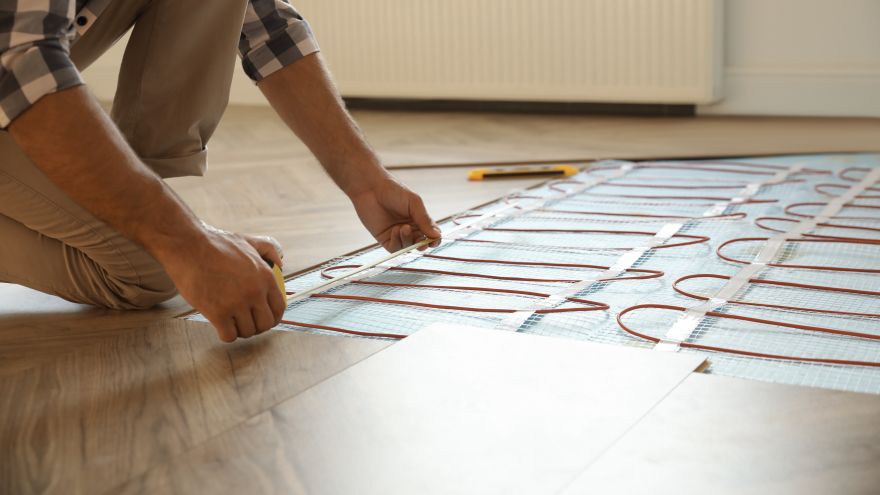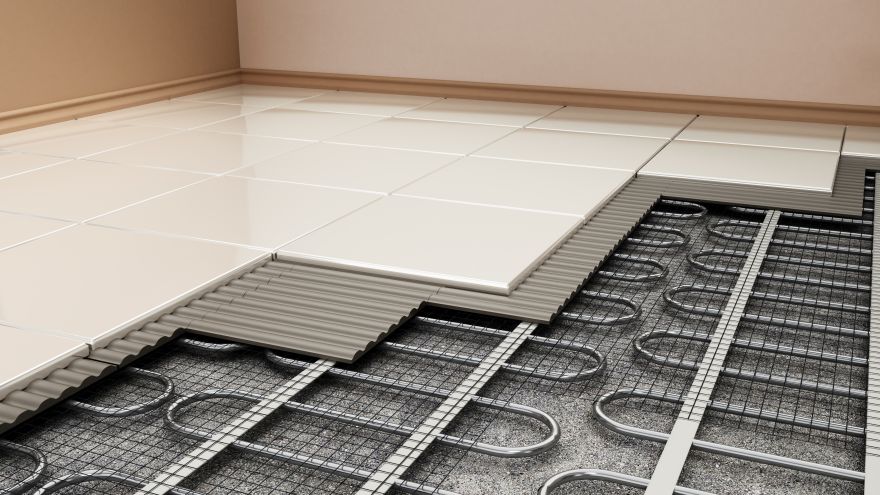Underfloor heating has become quite popular, but it is usually associated with home installations. However, under certain conditions, they can be installed in blocks. It warms the rooms from below, providing the appropriate temperature distribution ensuring comfort - warmer lower, cooler higher. It can be an alternative or complement to central heating .
Types of underfloor heating
Low-temperature surface underfloor heating is a system that keeps the floor heat lower than wall radiators. There are three types of such heating installations:
- water underfloor heating – hot water flows through a system of plastic or copper heating pipes. The floor is laid above them, e.g. tiles or carpet. Not suitable for wooden floors;
- electric underfloor heating – there are wires, foils or heating mats in the floor that transfer heat to the room. They heat up thanks to appropriately selected electrical resistance. Infrared heating is also used, mounted e.g. under the panels. The temperature is regulated by thermostats or sensors;
- air heating – connects the foundation slab with underfloor heating in a closed circuit. Air heat is provided by a heater or a forced-air furnace. It is rare in Poland and is not suitable for heating an apartment.
Check out underfloor heating products
Water installations have high thermal inertia, which means that on the one hand they take a long time to heat up and, on the other hand, they also transfer heat to the surroundings for a long time. The pipes are laid directly on the thermal and moisture insulation or 1 cm above it. They are poured with screed and then the floor finish is installed. Before installing water underfloor heating, you need to prepare a design, because later changes are impossible.
The electric flooring version uses cables (most often), mats - meshes with a heating cable woven in - or polyester foils with embedded flat aluminum wires. When the heating elements are located directly under the floor, the heating works quickly after being turned on. If there is a thicker layer of concrete screed above them, we get an accumulative version: underfloor heating can be charged during a lower price tariff. Then the heat is released gradually.
Why is it worth using underfloor heating?
It is a very efficient, effective and low-failure system, as well as economical. With higher installation costs, especially water underfloor heating, than traditional heating with wall-mounted radiators, operation is usually cheaper - the water in the pipes has a much lower temperature. The heat spreads over the entire surface, heating the room evenly. The temperature distribution is favorable - it is warmer in the legs and cooler in the head. Less air circulation means there is less dust, mites and other microorganisms. Additionally, it is easier to achieve the appropriate humidity.
 The underfloor heating installation does not have to be installed throughout the entire apartment, you can choose whether it will be a bathroom, kitchen or living room. In bathrooms, it should not be installed under a bathtub or shower. Additionally, removing the radiators improves the aesthetics of the interior and creates more space. The system also works perfectly in high rooms - in the case of traditional heating devices, the heat rises to the ceiling. It is also easy to adjust the temperature to the appropriate level and maintain it. There is also no dust burning effect, which occurs in wall radiators when the water temperature exceeds 50 degrees C (required due to the smaller heating surface).
The underfloor heating installation does not have to be installed throughout the entire apartment, you can choose whether it will be a bathroom, kitchen or living room. In bathrooms, it should not be installed under a bathtub or shower. Additionally, removing the radiators improves the aesthetics of the interior and creates more space. The system also works perfectly in high rooms - in the case of traditional heating devices, the heat rises to the ceiling. It is also easy to adjust the temperature to the appropriate level and maintain it. There is also no dust burning effect, which occurs in wall radiators when the water temperature exceeds 50 degrees C (required due to the smaller heating surface).
However, it should be added that the installation makes sense when the block has undergone thermal modernization and is well insulated and equipped with tight windows. If not, the walls freeze in winter and heat escapes through the leaks in the window frames. It is then difficult to achieve thermal comfort and reduce heating costs - low-temperature systems provide adequate heat in rooms at 20 degrees C, two degrees lower than in traditional solutions. And that already means losses.
The possibility of arranging furniture is also limited - the floor installation under it is less efficient. But the solution is wardrobes, chests of drawers or shelves on legs.
Can you install underfloor heating in a block of flats?
The answer is yes, but... In cooperative blocks or blocks managed by a housing community , the central heating installation is considered a common part of the building . And the installation of surface heating requires interference in its elements. In such a situation , the management board must consent to the work with the consent of the members of the cooperative or community . Typically, where individual heat meters are placed, consent is given. One, in the case of flat-rate fees, tenants may object because it is impossible to calculate unit heat consumption. It may also be necessary to assess the technical condition of the building and the load-bearing capacity of the ceilings, because in some cases underfloor heating will be an additional burden.
Check out underfloor heating products
How to choose a flooring installation method
If you decide to install water underfloor heating, you can choose a wet installation with a concrete screed (renovation required) or a lightweight system consisting of polystyrene panels with aluminum sheet. The second option is to install polystyrene panels covered with aluminum sheets on top. In this way, there is no load on the ceiling and the floor rises by about 5 cm.
Copper or plastic pipes are used in water installations. The first ones are durable and resistant, but their price is much higher. Pipes made of polybutylene, network polyethylene or polypropylene can also be used for heating.
Before installation, the substrate must be leveled, cleaned and dried. Insulation made of a damp-proof foil and polystyrene is placed on it, as well as another foil with an anchor mesh for attaching the cables. These are arranged in a meandering or loop shape, preferably from a window or door (the greatest heat loss). If there are more loops at the input and output of the installation, water distribution manifolds are installed. The next step is a pressure test, which will reveal any leaks. Then, a peripheral expansion joint with slots is placed over the power cables - it ensures proper operation. The last element is the self-leveling screed. Ceramic tiles or panels are placed on it.
 Cables, mats or foils in electric heating are covered with a thin-layer screed of self-leveling compound or placed in a layer of flexible adhesive under the floor. The load is minimal, the floor level rises slightly. The installation is similar to that in water systems, instead of pipes, electric heating elements are placed and the ends of the wires are placed in an installation box previously installed in the wall. After attaching the structure (in the bathroom, a layer of moisture insulation is also used), it is poured with plastic mortar.
Cables, mats or foils in electric heating are covered with a thin-layer screed of self-leveling compound or placed in a layer of flexible adhesive under the floor. The load is minimal, the floor level rises slightly. The installation is similar to that in water systems, instead of pipes, electric heating elements are placed and the ends of the wires are placed in an installation box previously installed in the wall. After attaching the structure (in the bathroom, a layer of moisture insulation is also used), it is poured with plastic mortar.
The costs of installing water heating in the average price range range from PLN 140-160/m2 to PLN 200/m2 when using higher quality materials (including thermostats). For electrical installations, the amounts range from PLN 150 to PLN 300/m2.
If you are installing underfloor heating, check the products offered in the Onnline online wholesaler:
- Onnline corrugated conduit is easy to replace and protects utility lines. It also provides protection in construction conditions.
- Flamco Meibes underfloor heating – Kombibox RTL white – adjustable, with return temperature function.
- Danfoss straight valve - RTL set : straight valve and white head for regulating the temperature of flowing water.
- Protective pipe (conduit) - InGremio , protects media cables. The strength of 500 N makes it a good choice even for places with high protection requirements. The protection level is IP40.
- IMI Heimer Dynacon Eclipse 7-circuit manifold for underfloor heating with automatic flow limiters.

